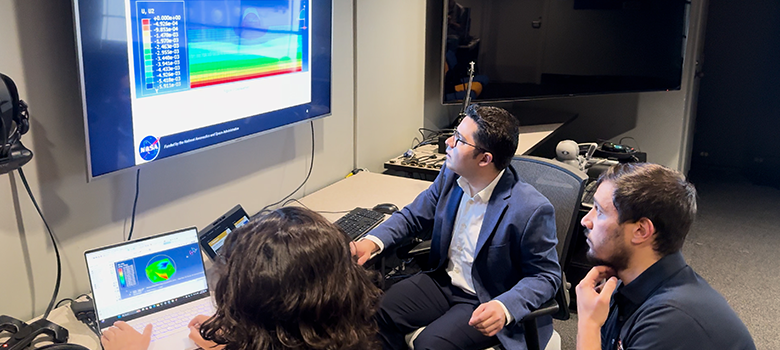
JANUARY 13, 2025 — As space missions beyond Earth become more ambitious, NASA needs to develop new ways to keep habitats operational when they are not occupied by astronauts.
UTSA Civil and Mechanical Engineering Professor Arturo Montoya and his students are laying the foundation for a future in space as part of a NASA-funded project that began in 2019. The Resilient Extraterrestrial Habitat Institute (RETHi) focuses on developing lunar habitats that can handle the harsh conditions of space while providing shelter for astronauts living and working on the moon.
“The simulations being conducted at UTSA are truly unique, representing a pioneering effort in this field. We are advancing both knowledge and science,” Montoya said.
Dylan Bohanan, a mechanical engineering graduate student, and Ali Al-Zoubi, a civil engineering graduate student, are part of the UTSA research team aiming to create adaptable habitats that can endure expected and unexpected space disruptions. Using computer simulations, they test how these habitats will survive meteorite impacts, low gravity, moonquakes and extreme temperatures.
“It's a very big opportunity, at least from when I was little, I always wanted to do NASA stuff, you know, you see all that, all those things, especially coming from Texas and San Antonio especially, and it's just a great opportunity to have those experiences and actually work on something that, like I could only dream of when I was younger,” Bohanan said.
Montoya and his students are playing a key role in the state’s efforts to propel space exploration. Last year, Texas Governor Greg Abbott launched the Texas Space Commission, which aims to boost innovation in space, aeronautics and aviation within the state.
“It has been a privilege to witness UTSA's rise to an R1 research institution and to contribute to groundbreaking events that will shape the future,” Montoya said.
The UTSA researchers are collaborating with experts from Purdue, the University of Connecticut, Harvard and Mississippi State.

UTSA researchers from the Resilient Extraterrestrial Habitat Institute are working to develop lunar habitats that can handle the harsh conditions of space.
Last month, UTSA announced the launch of the Center for Space Technology and Operations Research (CSTOR), a new research center dedicated to advancing engineering, technology and operations that will support space missions between the Earth and the Moon, an area referred to as cislunar space, as well as the lunar surface. The center will address the growing demand for research and workforce development by civil, commercial and national security space agencies and companies.
CSTOR includes more than 35 UTSA researchers advancing work in areas such as uncrewed spacecraft, lunar habitation, hypersonics and propulsion. Additionally, over 200 undergraduate and graduate students at the university are preparing for careers in these areas.
UTSA Today is produced by University Communications and Marketing, the official news source of The University of Texas at San Antonio. Send your feedback to news@utsa.edu. Keep up-to-date on UTSA news by visiting UTSA Today. Connect with UTSA online at Facebook, Twitter, Youtube and Instagram.
Covidence is a systematic & scoping review tool used to streamline the process of screening and reviewing articles. Using this software, research teams can easily import studies, perform automatic deduplication, and extract data using templates. This workshop will show attendees how to start a review in Covidence, add collaborators, and get started on screening.
Virtual (Zoom)In this workshop, attendees will be introduced to Pandas, a Python tool for working with data easily. It makes it simple to organize and analyze information when data is organized and categorized, like spreadsheets or tables.
Group Spot B, John Peace LibraryEach fall and spring semester, students convene at the Main Campus at UTSA with booths, ideas and prototypes. A crowd of judges, local organizations, students, faculty and sponsors walk around and talk to the students about their projects and ask questions. Students get the real-life experience of "pitching" their project with hopes of getting funding or support to move to the next level.
UTSA Convocation Center, Main CampusJoin the doctoral candidates for the Doctoral Conferreal Ceremony and celebrate their accomplishments.
Arts Building Recital Hall, Main CampusCelebrate the graduates from the Carlos Alvarez College of Business, College of Education and Human Development, Margie and Bill Klesse College of Engineering and Integrated Design and University College.
AlamodomeCelebrate the graduates from the College for Health, Community and Policy, College of Liberal and Fine Arts and College of Sciences.
AlamodomeThe University of Texas at San Antonio is dedicated to the advancement of knowledge through research and discovery, teaching and learning, community engagement and public service. As an institution of access and excellence, UTSA embraces multicultural traditions and serves as a center for intellectual and creative resources as well as a catalyst for socioeconomic development and the commercialization of intellectual property - for Texas, the nation and the world.
To be a premier public research university, providing access to educational excellence and preparing citizen leaders for the global environment.
We encourage an environment of dialogue and discovery, where integrity, excellence, respect, collaboration and innovation are fostered.